SEEK Limited Corporate Finance: Share Performance and Governance
VerifiedAdded on 2023/06/11
|17
|3281
|269
Case Study
AI Summary
This case study provides a comprehensive financial analysis of SEEK Limited, an Australian online employment marketplace. It examines the company's corporate governance structure, including the roles of the CEO and board of directors, and its corporate social responsibility initiatives. The analysis includes an assessment of the company's risk and return profile, with calculations of historical risk parameters and the required rate of return using the CAPM model. The study also evaluates SEEK Limited's earnings and cash flow, comparing its share price movement with the All Ordinaries Index. Furthermore, the report delves into the company's capital structure, dividend policy, and financing sources, computing the cost of debt, equity, and weighted average cost of capital (WACC). The findings suggest that SEEK Limited exhibits a satisfactory financial performance and maintains a relatively stable price-earnings ratio.

Running head: CORPOARATE FINANCE
Corporate finance
Name of the student
Name of the university
Student ID
Author note
Corporate finance
Name of the student
Name of the university
Student ID
Author note
Paraphrase This Document
Need a fresh take? Get an instant paraphrase of this document with our AI Paraphraser
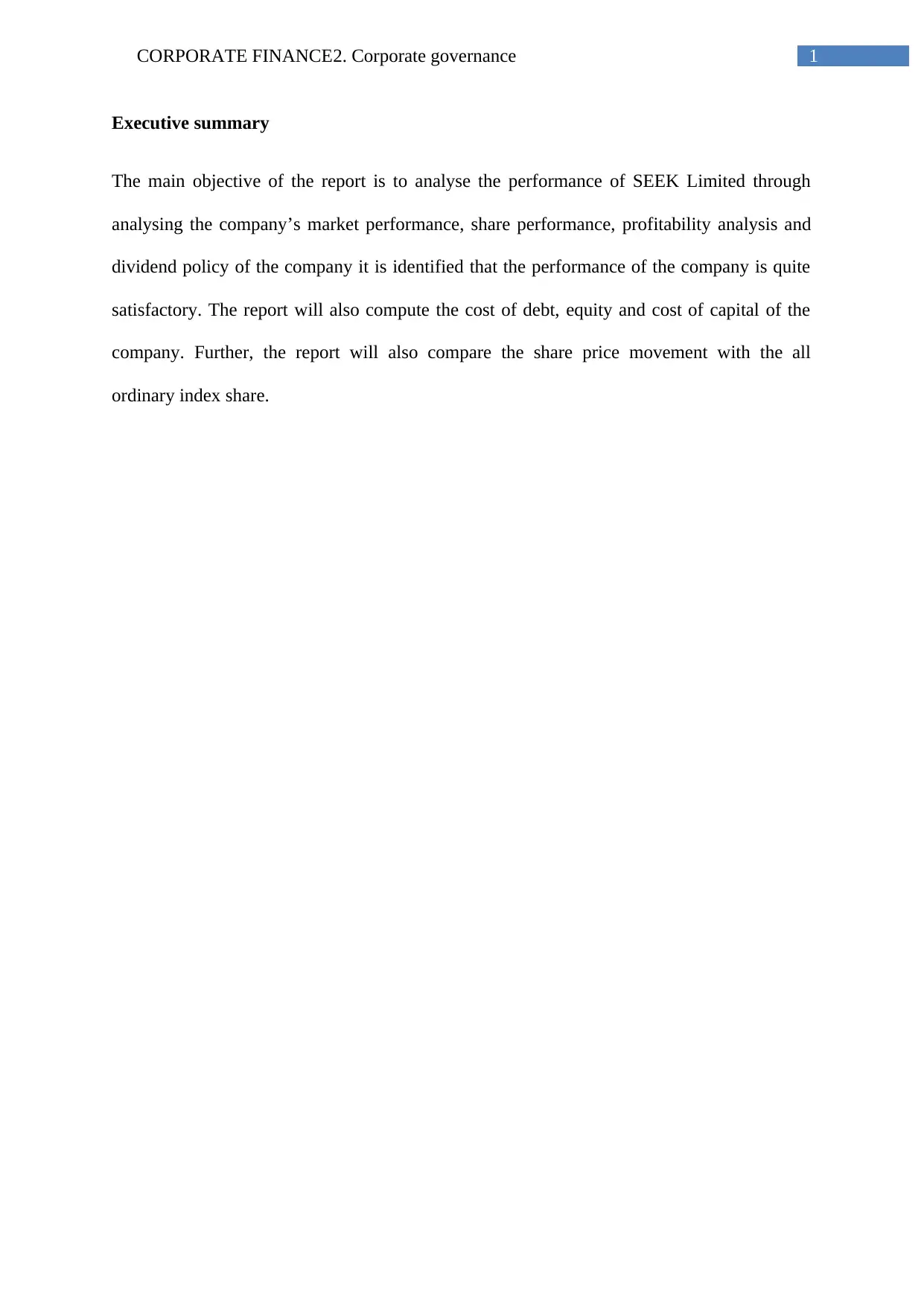
1CORPORATE FINANCE2. Corporate governance
Executive summary
The main objective of the report is to analyse the performance of SEEK Limited through
analysing the company’s market performance, share performance, profitability analysis and
dividend policy of the company it is identified that the performance of the company is quite
satisfactory. The report will also compute the cost of debt, equity and cost of capital of the
company. Further, the report will also compare the share price movement with the all
ordinary index share.
Executive summary
The main objective of the report is to analyse the performance of SEEK Limited through
analysing the company’s market performance, share performance, profitability analysis and
dividend policy of the company it is identified that the performance of the company is quite
satisfactory. The report will also compute the cost of debt, equity and cost of capital of the
company. Further, the report will also compare the share price movement with the all
ordinary index share.
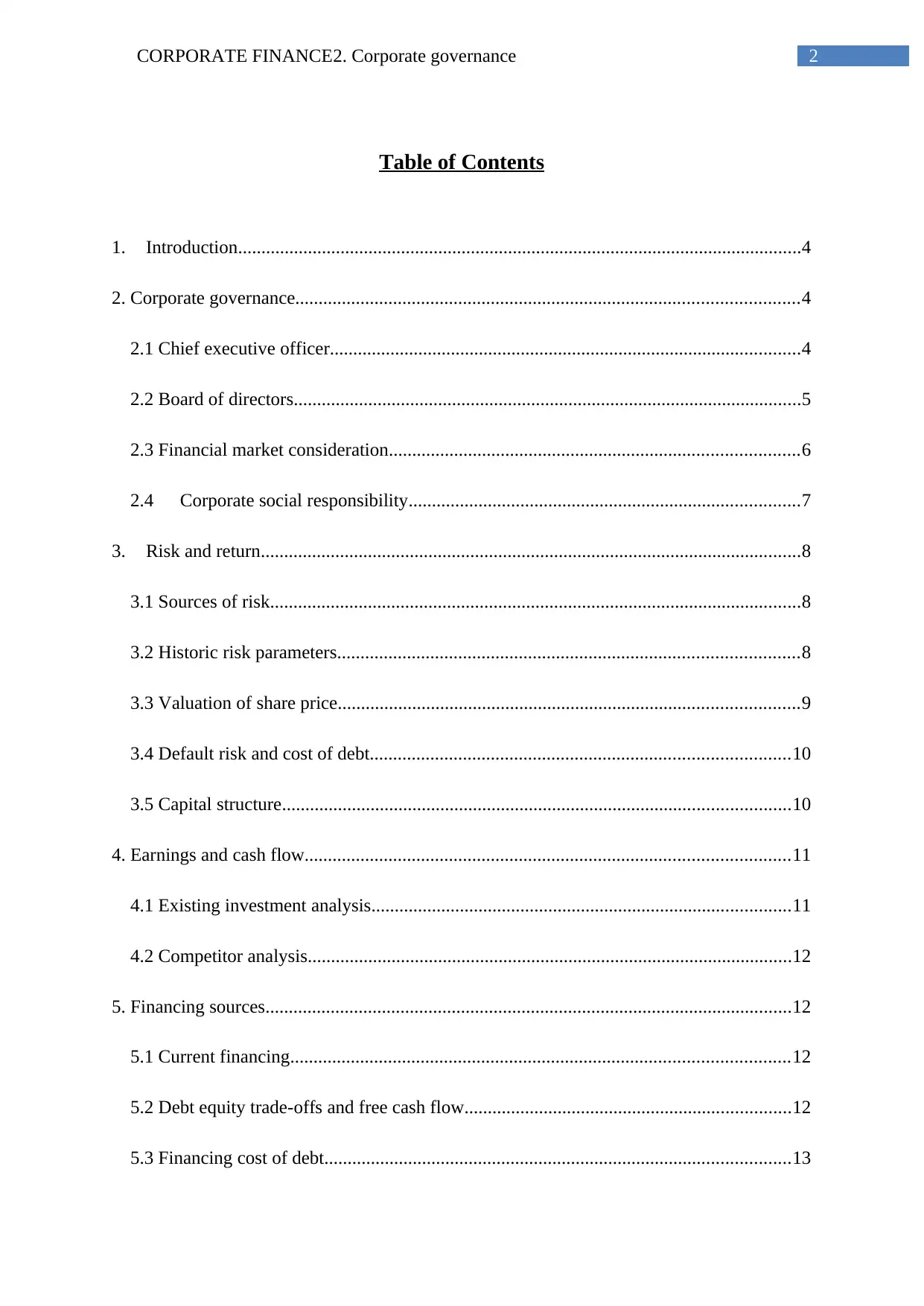
2CORPORATE FINANCE2. Corporate governance
Table of Contents
1. Introduction.........................................................................................................................4
2. Corporate governance............................................................................................................4
2.1 Chief executive officer.....................................................................................................4
2.2 Board of directors.............................................................................................................5
2.3 Financial market consideration........................................................................................6
2.4 Corporate social responsibility....................................................................................7
3. Risk and return....................................................................................................................8
3.1 Sources of risk..................................................................................................................8
3.2 Historic risk parameters...................................................................................................8
3.3 Valuation of share price...................................................................................................9
3.4 Default risk and cost of debt..........................................................................................10
3.5 Capital structure.............................................................................................................10
4. Earnings and cash flow........................................................................................................11
4.1 Existing investment analysis..........................................................................................11
4.2 Competitor analysis........................................................................................................12
5. Financing sources.................................................................................................................12
5.1 Current financing...........................................................................................................12
5.2 Debt equity trade-offs and free cash flow......................................................................12
5.3 Financing cost of debt....................................................................................................13
Table of Contents
1. Introduction.........................................................................................................................4
2. Corporate governance............................................................................................................4
2.1 Chief executive officer.....................................................................................................4
2.2 Board of directors.............................................................................................................5
2.3 Financial market consideration........................................................................................6
2.4 Corporate social responsibility....................................................................................7
3. Risk and return....................................................................................................................8
3.1 Sources of risk..................................................................................................................8
3.2 Historic risk parameters...................................................................................................8
3.3 Valuation of share price...................................................................................................9
3.4 Default risk and cost of debt..........................................................................................10
3.5 Capital structure.............................................................................................................10
4. Earnings and cash flow........................................................................................................11
4.1 Existing investment analysis..........................................................................................11
4.2 Competitor analysis........................................................................................................12
5. Financing sources.................................................................................................................12
5.1 Current financing...........................................................................................................12
5.2 Debt equity trade-offs and free cash flow......................................................................12
5.3 Financing cost of debt....................................................................................................13
You're viewing a preview
Unlock full access by subscribing today!
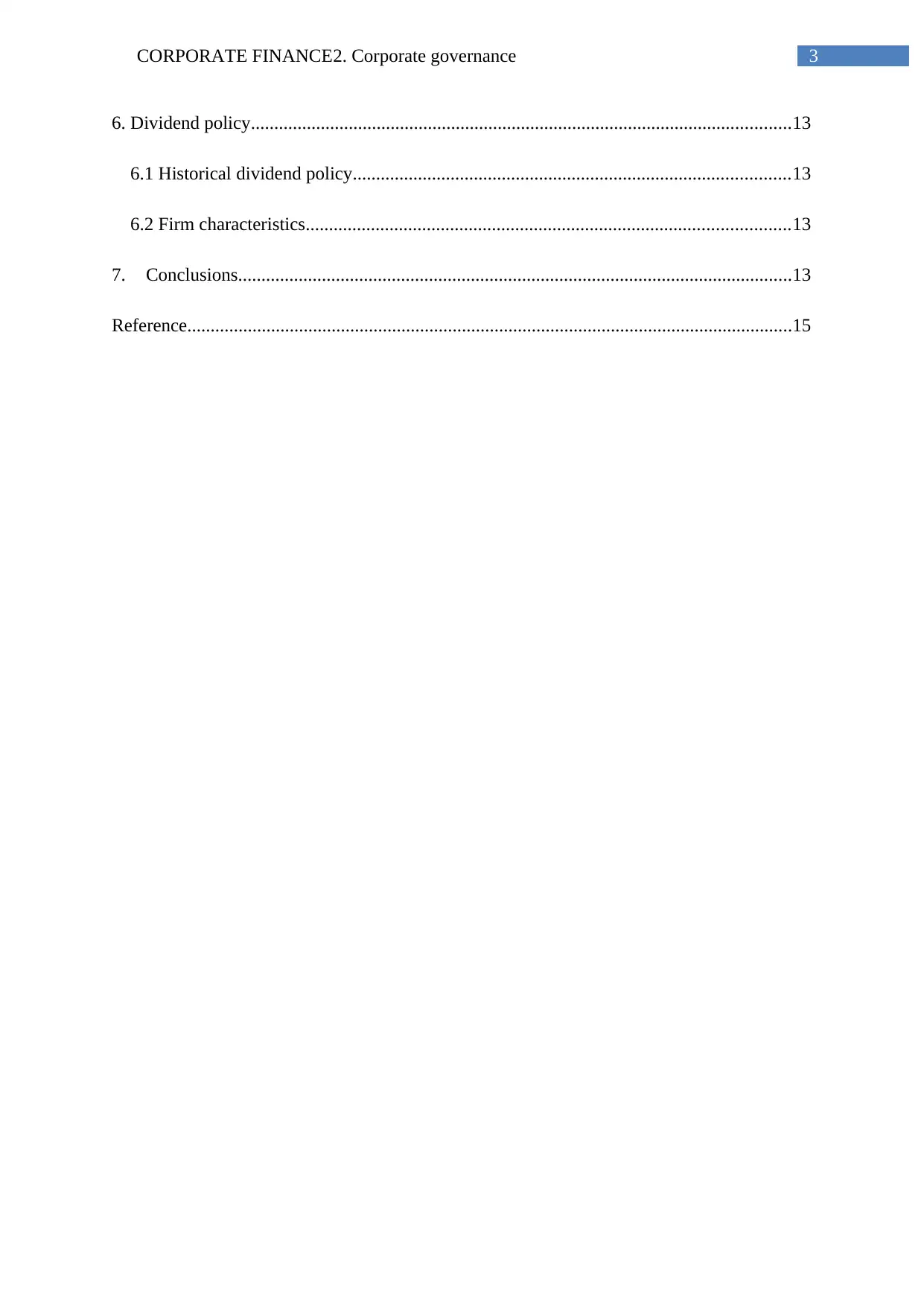
3CORPORATE FINANCE2. Corporate governance
6. Dividend policy....................................................................................................................13
6.1 Historical dividend policy..............................................................................................13
6.2 Firm characteristics........................................................................................................13
7. Conclusions.......................................................................................................................13
Reference..................................................................................................................................15
6. Dividend policy....................................................................................................................13
6.1 Historical dividend policy..............................................................................................13
6.2 Firm characteristics........................................................................................................13
7. Conclusions.......................................................................................................................13
Reference..................................................................................................................................15
Paraphrase This Document
Need a fresh take? Get an instant paraphrase of this document with our AI Paraphraser
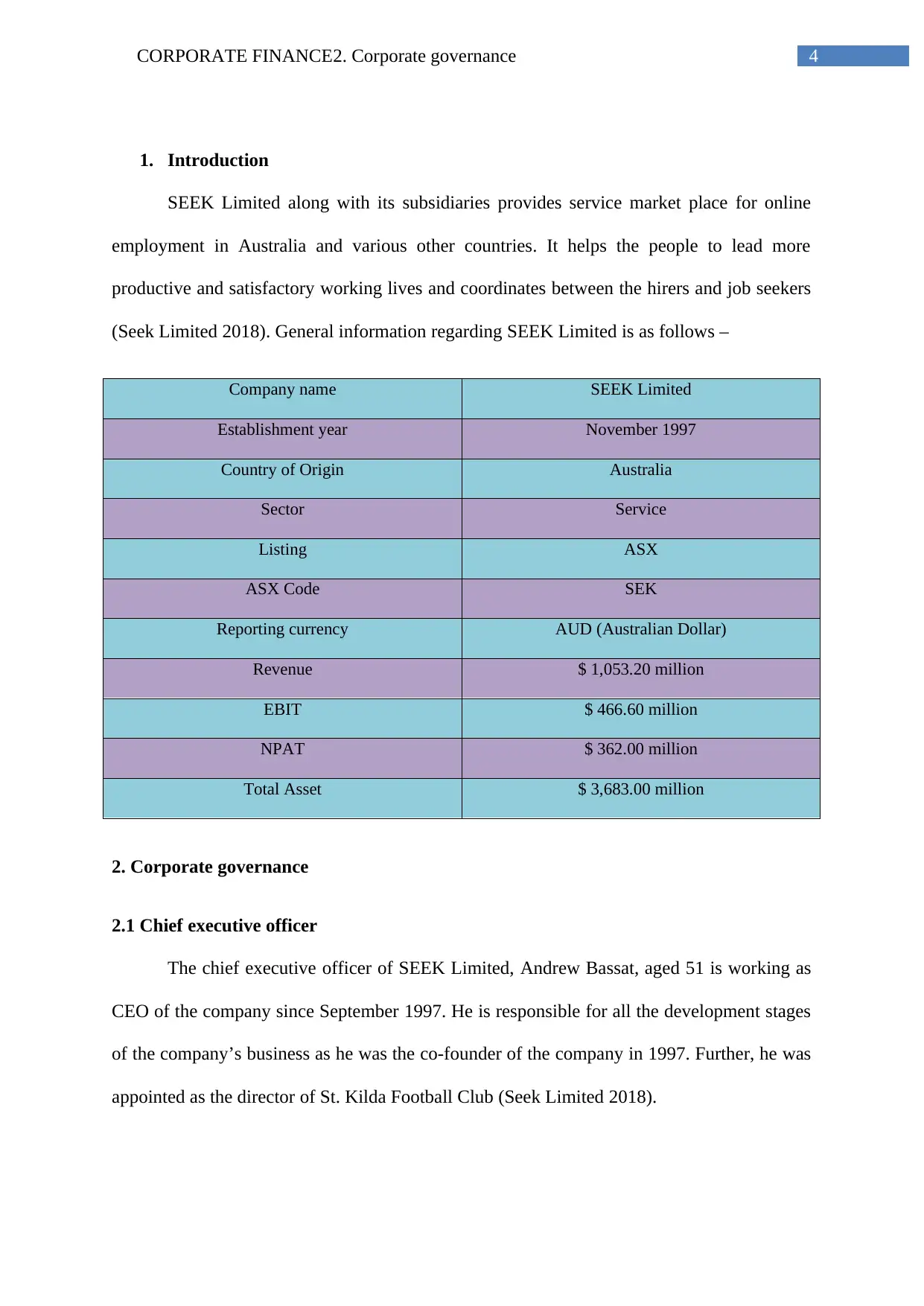
4CORPORATE FINANCE2. Corporate governance
1. Introduction
SEEK Limited along with its subsidiaries provides service market place for online
employment in Australia and various other countries. It helps the people to lead more
productive and satisfactory working lives and coordinates between the hirers and job seekers
(Seek Limited 2018). General information regarding SEEK Limited is as follows –
Company name SEEK Limited
Establishment year November 1997
Country of Origin Australia
Sector Service
Listing ASX
ASX Code SEK
Reporting currency AUD (Australian Dollar)
Revenue $ 1,053.20 million
EBIT $ 466.60 million
NPAT $ 362.00 million
Total Asset $ 3,683.00 million
2. Corporate governance
2.1 Chief executive officer
The chief executive officer of SEEK Limited, Andrew Bassat, aged 51 is working as
CEO of the company since September 1997. He is responsible for all the development stages
of the company’s business as he was the co-founder of the company in 1997. Further, he was
appointed as the director of St. Kilda Football Club (Seek Limited 2018).
1. Introduction
SEEK Limited along with its subsidiaries provides service market place for online
employment in Australia and various other countries. It helps the people to lead more
productive and satisfactory working lives and coordinates between the hirers and job seekers
(Seek Limited 2018). General information regarding SEEK Limited is as follows –
Company name SEEK Limited
Establishment year November 1997
Country of Origin Australia
Sector Service
Listing ASX
ASX Code SEK
Reporting currency AUD (Australian Dollar)
Revenue $ 1,053.20 million
EBIT $ 466.60 million
NPAT $ 362.00 million
Total Asset $ 3,683.00 million
2. Corporate governance
2.1 Chief executive officer
The chief executive officer of SEEK Limited, Andrew Bassat, aged 51 is working as
CEO of the company since September 1997. He is responsible for all the development stages
of the company’s business as he was the co-founder of the company in 1997. Further, he was
appointed as the director of St. Kilda Football Club (Seek Limited 2018).
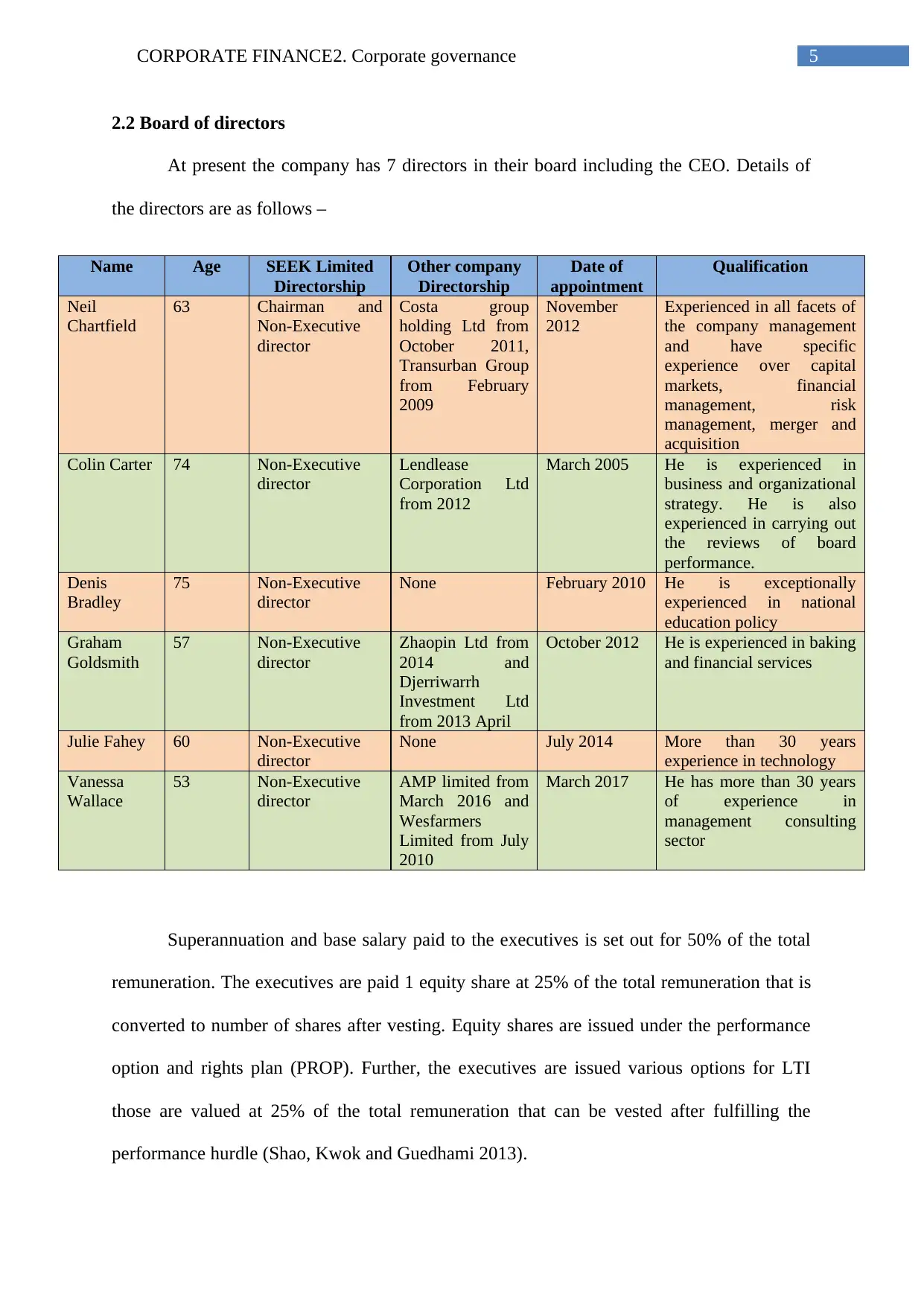
5CORPORATE FINANCE2. Corporate governance
2.2 Board of directors
At present the company has 7 directors in their board including the CEO. Details of
the directors are as follows –
Name Age SEEK Limited
Directorship
Other company
Directorship
Date of
appointment
Qualification
Neil
Chartfield
63 Chairman and
Non-Executive
director
Costa group
holding Ltd from
October 2011,
Transurban Group
from February
2009
November
2012
Experienced in all facets of
the company management
and have specific
experience over capital
markets, financial
management, risk
management, merger and
acquisition
Colin Carter 74 Non-Executive
director
Lendlease
Corporation Ltd
from 2012
March 2005 He is experienced in
business and organizational
strategy. He is also
experienced in carrying out
the reviews of board
performance.
Denis
Bradley
75 Non-Executive
director
None February 2010 He is exceptionally
experienced in national
education policy
Graham
Goldsmith
57 Non-Executive
director
Zhaopin Ltd from
2014 and
Djerriwarrh
Investment Ltd
from 2013 April
October 2012 He is experienced in baking
and financial services
Julie Fahey 60 Non-Executive
director
None July 2014 More than 30 years
experience in technology
Vanessa
Wallace
53 Non-Executive
director
AMP limited from
March 2016 and
Wesfarmers
Limited from July
2010
March 2017 He has more than 30 years
of experience in
management consulting
sector
Superannuation and base salary paid to the executives is set out for 50% of the total
remuneration. The executives are paid 1 equity share at 25% of the total remuneration that is
converted to number of shares after vesting. Equity shares are issued under the performance
option and rights plan (PROP). Further, the executives are issued various options for LTI
those are valued at 25% of the total remuneration that can be vested after fulfilling the
performance hurdle (Shao, Kwok and Guedhami 2013).
2.2 Board of directors
At present the company has 7 directors in their board including the CEO. Details of
the directors are as follows –
Name Age SEEK Limited
Directorship
Other company
Directorship
Date of
appointment
Qualification
Neil
Chartfield
63 Chairman and
Non-Executive
director
Costa group
holding Ltd from
October 2011,
Transurban Group
from February
2009
November
2012
Experienced in all facets of
the company management
and have specific
experience over capital
markets, financial
management, risk
management, merger and
acquisition
Colin Carter 74 Non-Executive
director
Lendlease
Corporation Ltd
from 2012
March 2005 He is experienced in
business and organizational
strategy. He is also
experienced in carrying out
the reviews of board
performance.
Denis
Bradley
75 Non-Executive
director
None February 2010 He is exceptionally
experienced in national
education policy
Graham
Goldsmith
57 Non-Executive
director
Zhaopin Ltd from
2014 and
Djerriwarrh
Investment Ltd
from 2013 April
October 2012 He is experienced in baking
and financial services
Julie Fahey 60 Non-Executive
director
None July 2014 More than 30 years
experience in technology
Vanessa
Wallace
53 Non-Executive
director
AMP limited from
March 2016 and
Wesfarmers
Limited from July
2010
March 2017 He has more than 30 years
of experience in
management consulting
sector
Superannuation and base salary paid to the executives is set out for 50% of the total
remuneration. The executives are paid 1 equity share at 25% of the total remuneration that is
converted to number of shares after vesting. Equity shares are issued under the performance
option and rights plan (PROP). Further, the executives are issued various options for LTI
those are valued at 25% of the total remuneration that can be vested after fulfilling the
performance hurdle (Shao, Kwok and Guedhami 2013).
You're viewing a preview
Unlock full access by subscribing today!
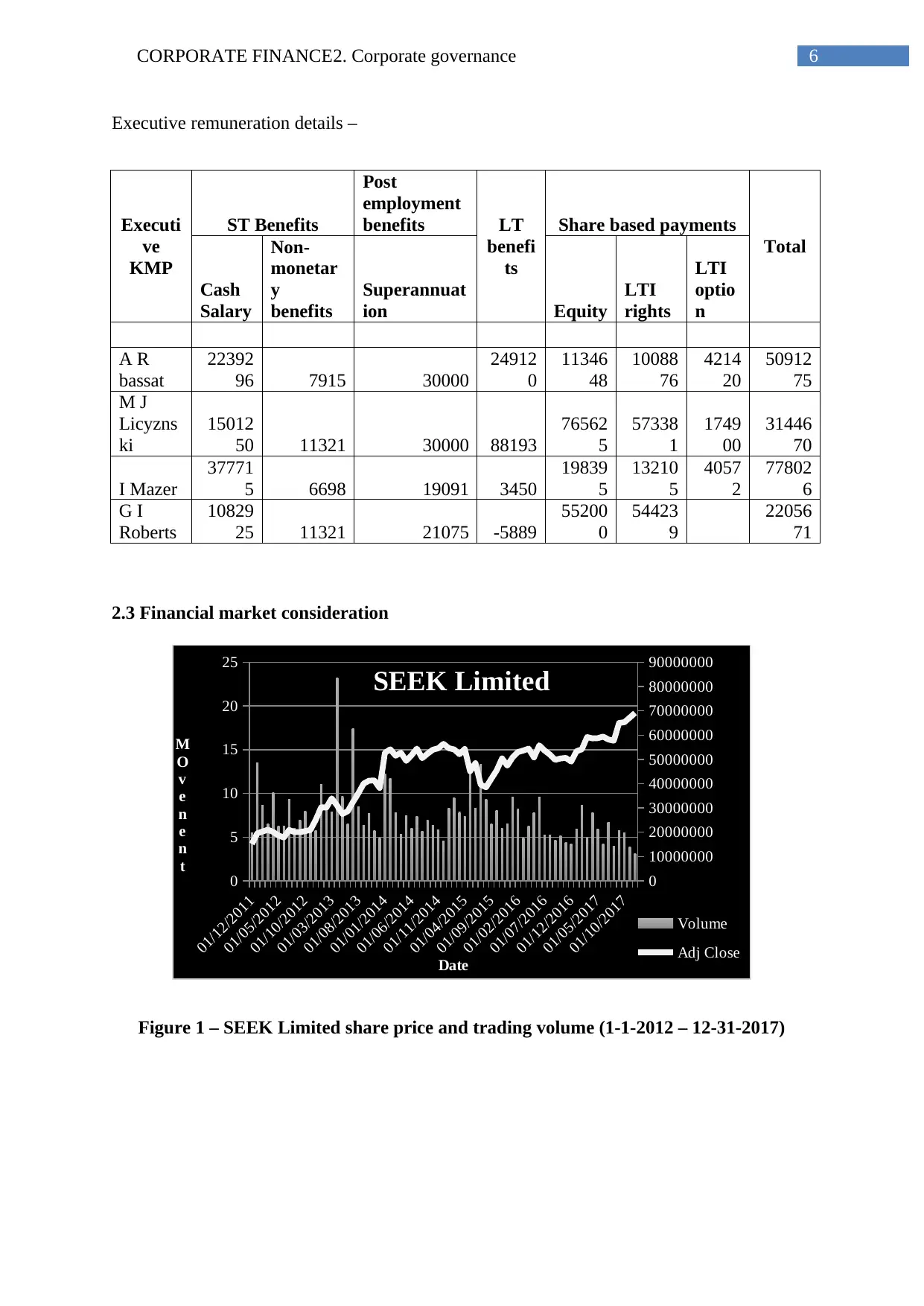
6CORPORATE FINANCE2. Corporate governance
Executive remuneration details –
Executi
ve
KMP
ST Benefits
Post
employment
benefits LT
benefi
ts
Share based payments
Total
Cash
Salary
Non-
monetar
y
benefits
Superannuat
ion Equity
LTI
rights
LTI
optio
n
A R
bassat
22392
96 7915 30000
24912
0
11346
48
10088
76
4214
20
50912
75
M J
Licyzns
ki
15012
50 11321 30000 88193
76562
5
57338
1
1749
00
31446
70
I Mazer
37771
5 6698 19091 3450
19839
5
13210
5
4057
2
77802
6
G I
Roberts
10829
25 11321 21075 -5889
55200
0
54423
9
22056
71
2.3 Financial market consideration
01/12/2011
01/05/2012
01/10/2012
01/03/2013
01/08/2013
01/01/2014
01/06/2014
01/11/2014
01/04/2015
01/09/2015
01/02/2016
01/07/2016
01/12/2016
01/05/2017
01/10/2017
0
5
10
15
20
25
0
10000000
20000000
30000000
40000000
50000000
60000000
70000000
80000000
90000000
SEEK Limited
Volume
Adj Close
Date
M
O
v
e
n
e
n
t
Figure 1 – SEEK Limited share price and trading volume (1-1-2012 – 12-31-2017)
Executive remuneration details –
Executi
ve
KMP
ST Benefits
Post
employment
benefits LT
benefi
ts
Share based payments
Total
Cash
Salary
Non-
monetar
y
benefits
Superannuat
ion Equity
LTI
rights
LTI
optio
n
A R
bassat
22392
96 7915 30000
24912
0
11346
48
10088
76
4214
20
50912
75
M J
Licyzns
ki
15012
50 11321 30000 88193
76562
5
57338
1
1749
00
31446
70
I Mazer
37771
5 6698 19091 3450
19839
5
13210
5
4057
2
77802
6
G I
Roberts
10829
25 11321 21075 -5889
55200
0
54423
9
22056
71
2.3 Financial market consideration
01/12/2011
01/05/2012
01/10/2012
01/03/2013
01/08/2013
01/01/2014
01/06/2014
01/11/2014
01/04/2015
01/09/2015
01/02/2016
01/07/2016
01/12/2016
01/05/2017
01/10/2017
0
5
10
15
20
25
0
10000000
20000000
30000000
40000000
50000000
60000000
70000000
80000000
90000000
SEEK Limited
Volume
Adj Close
Date
M
O
v
e
n
e
n
t
Figure 1 – SEEK Limited share price and trading volume (1-1-2012 – 12-31-2017)
Paraphrase This Document
Need a fresh take? Get an instant paraphrase of this document with our AI Paraphraser
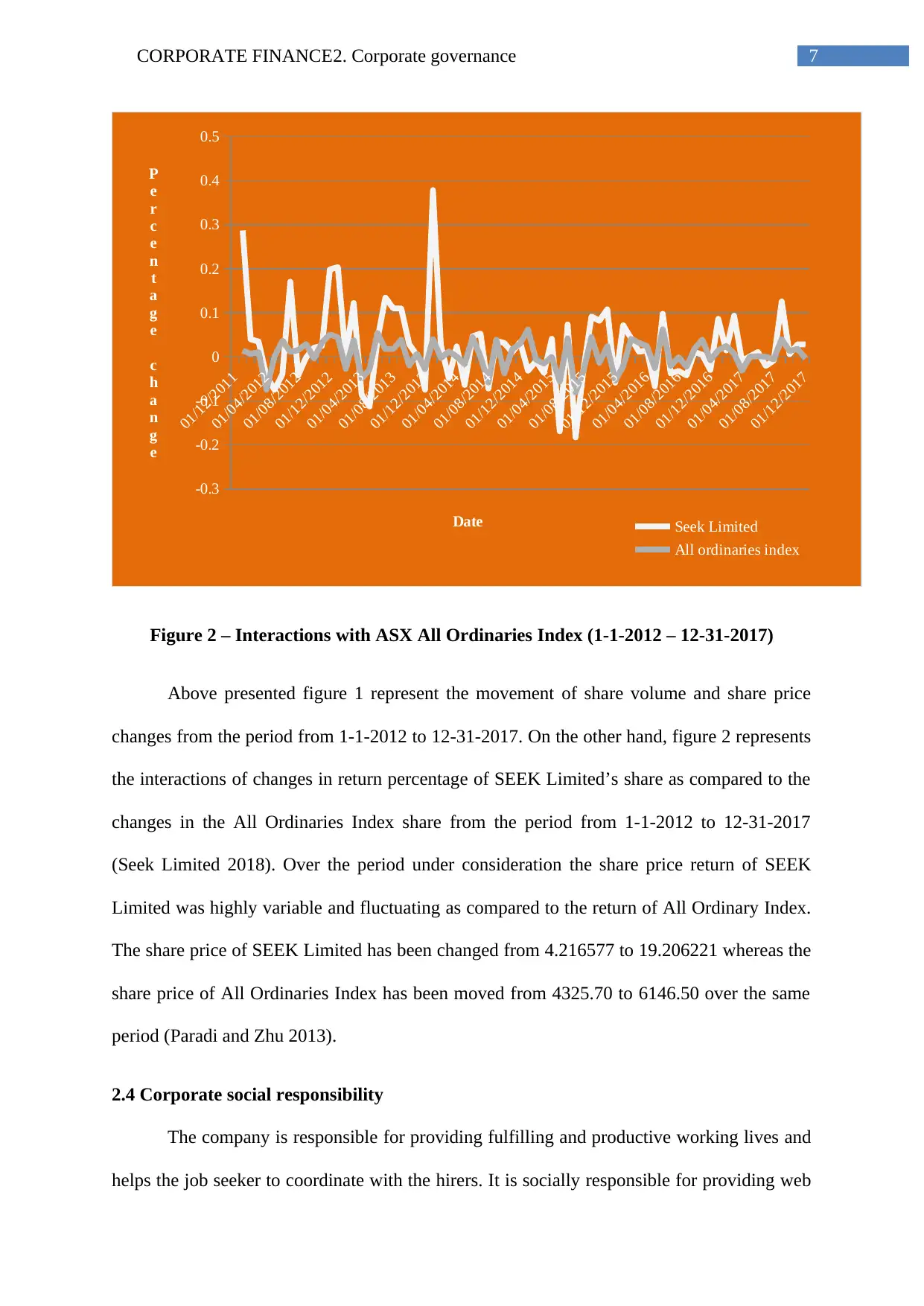
7CORPORATE FINANCE2. Corporate governance
01/12/2011
01/04/2012
01/08/2012
01/12/2012
01/04/2013
01/08/2013
01/12/2013
01/04/2014
01/08/2014
01/12/2014
01/04/2015
01/08/2015
01/12/2015
01/04/2016
01/08/2016
01/12/2016
01/04/2017
01/08/2017
01/12/2017
-0.3
-0.2
-0.1
0
0.1
0.2
0.3
0.4
0.5
Seek Limited
All ordinaries index
Date
P
e
r
c
e
n
t
a
g
e
c
h
a
n
g
e
Figure 2 – Interactions with ASX All Ordinaries Index (1-1-2012 – 12-31-2017)
Above presented figure 1 represent the movement of share volume and share price
changes from the period from 1-1-2012 to 12-31-2017. On the other hand, figure 2 represents
the interactions of changes in return percentage of SEEK Limited’s share as compared to the
changes in the All Ordinaries Index share from the period from 1-1-2012 to 12-31-2017
(Seek Limited 2018). Over the period under consideration the share price return of SEEK
Limited was highly variable and fluctuating as compared to the return of All Ordinary Index.
The share price of SEEK Limited has been changed from 4.216577 to 19.206221 whereas the
share price of All Ordinaries Index has been moved from 4325.70 to 6146.50 over the same
period (Paradi and Zhu 2013).
2.4 Corporate social responsibility
The company is responsible for providing fulfilling and productive working lives and
helps the job seeker to coordinate with the hirers. It is socially responsible for providing web
01/12/2011
01/04/2012
01/08/2012
01/12/2012
01/04/2013
01/08/2013
01/12/2013
01/04/2014
01/08/2014
01/12/2014
01/04/2015
01/08/2015
01/12/2015
01/04/2016
01/08/2016
01/12/2016
01/04/2017
01/08/2017
01/12/2017
-0.3
-0.2
-0.1
0
0.1
0.2
0.3
0.4
0.5
Seek Limited
All ordinaries index
Date
P
e
r
c
e
n
t
a
g
e
c
h
a
n
g
e
Figure 2 – Interactions with ASX All Ordinaries Index (1-1-2012 – 12-31-2017)
Above presented figure 1 represent the movement of share volume and share price
changes from the period from 1-1-2012 to 12-31-2017. On the other hand, figure 2 represents
the interactions of changes in return percentage of SEEK Limited’s share as compared to the
changes in the All Ordinaries Index share from the period from 1-1-2012 to 12-31-2017
(Seek Limited 2018). Over the period under consideration the share price return of SEEK
Limited was highly variable and fluctuating as compared to the return of All Ordinary Index.
The share price of SEEK Limited has been changed from 4.216577 to 19.206221 whereas the
share price of All Ordinaries Index has been moved from 4325.70 to 6146.50 over the same
period (Paradi and Zhu 2013).
2.4 Corporate social responsibility
The company is responsible for providing fulfilling and productive working lives and
helps the job seeker to coordinate with the hirers. It is socially responsible for providing web

8CORPORATE FINANCE2. Corporate governance
based platform for providing opportunities over cross cultural mission along with the
searchable portal of the company’s website. The company also make positive contribution to
community under which it operates and the company is focussed to obtain more value from
the investments it made and prioritise them to long-term strategic approach.
3. Risk and return
Risk score is the relevant measure to assess the attractiveness of the stock. It shows that the
risk score of SEEK Limited is 7.00 (Analytics 2018). The risk score of ‘0’ represents that the
company is exposed to high risk and on the contrary ‘10’ represents the company is exposed
to low risk. However, the risk score of SEEK Limited is higher as compared to its
competitors. It signifies that the company is considerably low risky as compared to its peers
(Kou, Peng and Wang 2014).
3.1 Sources of risk
Risk score is the relevant measure to assess the attractiveness of the stock. It shows
that the risk score of SEEK Limited is 7.00 (Analytics 2018). The risk score of ‘0’ represents
that the company is exposed to high risk and on the contrary ‘10’ represents the company is
exposed to low risk. However, the risk score of SEEK Limited is higher as compared to its
competitors. It signifies that the company is considerably low risky as compared to its peers.
3.2 Historic risk parameters
Statistics SEEK Limited All Ordinary Index
Mean 0.0250 0.0054
Standard Deviation (SD) 0.0901 0.0321
Coefficient of Variation (CV) 3.6012 5.9406
It can be identified from the above calculation table that the mean return of All
ordinary index is 0.0054 whereas the mean return of SEEK Limited is 0.0250. Therefore, the
based platform for providing opportunities over cross cultural mission along with the
searchable portal of the company’s website. The company also make positive contribution to
community under which it operates and the company is focussed to obtain more value from
the investments it made and prioritise them to long-term strategic approach.
3. Risk and return
Risk score is the relevant measure to assess the attractiveness of the stock. It shows that the
risk score of SEEK Limited is 7.00 (Analytics 2018). The risk score of ‘0’ represents that the
company is exposed to high risk and on the contrary ‘10’ represents the company is exposed
to low risk. However, the risk score of SEEK Limited is higher as compared to its
competitors. It signifies that the company is considerably low risky as compared to its peers
(Kou, Peng and Wang 2014).
3.1 Sources of risk
Risk score is the relevant measure to assess the attractiveness of the stock. It shows
that the risk score of SEEK Limited is 7.00 (Analytics 2018). The risk score of ‘0’ represents
that the company is exposed to high risk and on the contrary ‘10’ represents the company is
exposed to low risk. However, the risk score of SEEK Limited is higher as compared to its
competitors. It signifies that the company is considerably low risky as compared to its peers.
3.2 Historic risk parameters
Statistics SEEK Limited All Ordinary Index
Mean 0.0250 0.0054
Standard Deviation (SD) 0.0901 0.0321
Coefficient of Variation (CV) 3.6012 5.9406
It can be identified from the above calculation table that the mean return of All
ordinary index is 0.0054 whereas the mean return of SEEK Limited is 0.0250. Therefore, the
You're viewing a preview
Unlock full access by subscribing today!
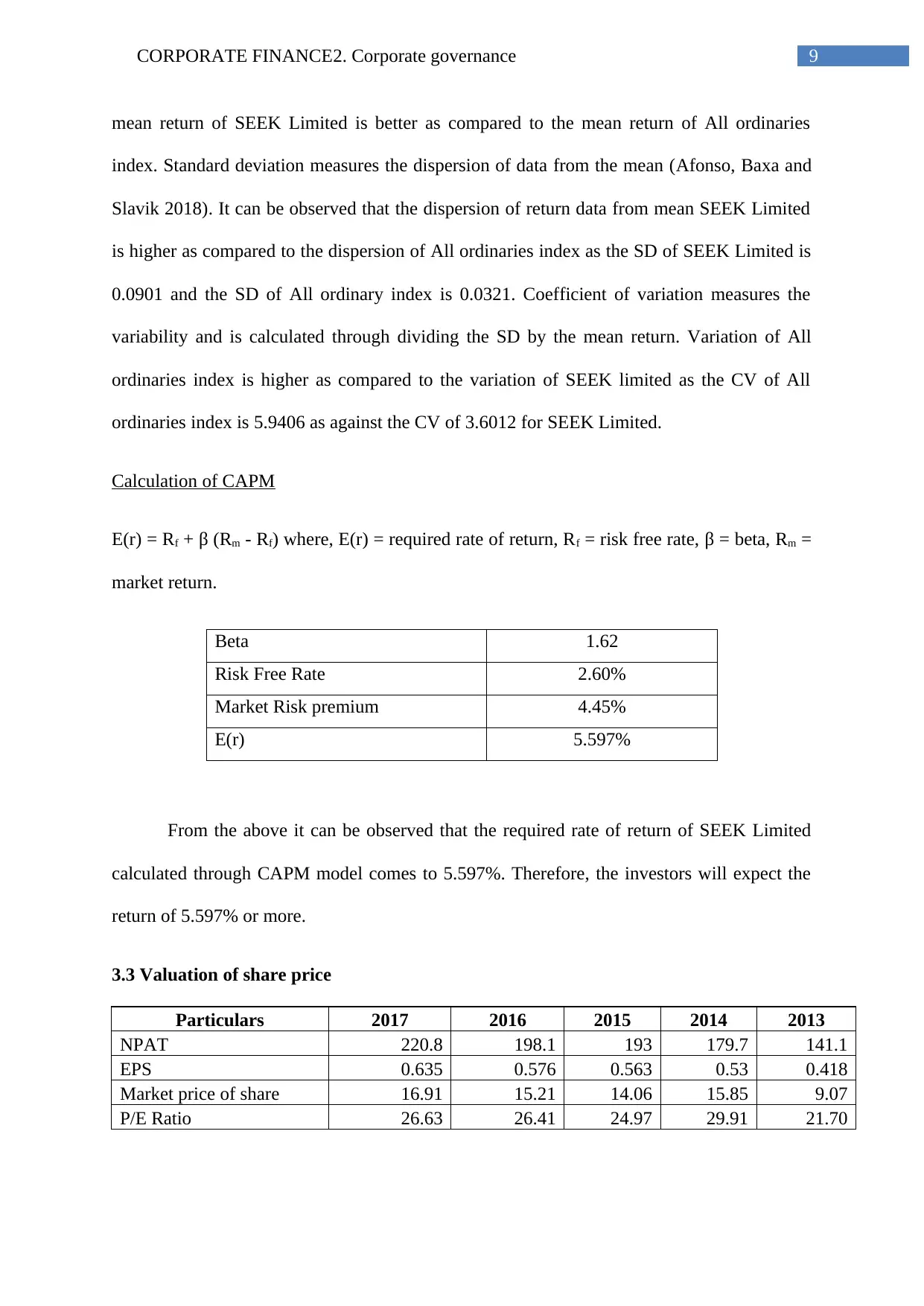
9CORPORATE FINANCE2. Corporate governance
mean return of SEEK Limited is better as compared to the mean return of All ordinaries
index. Standard deviation measures the dispersion of data from the mean (Afonso, Baxa and
Slavik 2018). It can be observed that the dispersion of return data from mean SEEK Limited
is higher as compared to the dispersion of All ordinaries index as the SD of SEEK Limited is
0.0901 and the SD of All ordinary index is 0.0321. Coefficient of variation measures the
variability and is calculated through dividing the SD by the mean return. Variation of All
ordinaries index is higher as compared to the variation of SEEK limited as the CV of All
ordinaries index is 5.9406 as against the CV of 3.6012 for SEEK Limited.
Calculation of CAPM
E(r) = Rf + β (Rm - Rf) where, E(r) = required rate of return, Rf = risk free rate, β = beta, Rm =
market return.
Beta 1.62
Risk Free Rate 2.60%
Market Risk premium 4.45%
E(r) 5.597%
From the above it can be observed that the required rate of return of SEEK Limited
calculated through CAPM model comes to 5.597%. Therefore, the investors will expect the
return of 5.597% or more.
3.3 Valuation of share price
Particulars 2017 2016 2015 2014 2013
NPAT 220.8 198.1 193 179.7 141.1
EPS 0.635 0.576 0.563 0.53 0.418
Market price of share 16.91 15.21 14.06 15.85 9.07
P/E Ratio 26.63 26.41 24.97 29.91 21.70
mean return of SEEK Limited is better as compared to the mean return of All ordinaries
index. Standard deviation measures the dispersion of data from the mean (Afonso, Baxa and
Slavik 2018). It can be observed that the dispersion of return data from mean SEEK Limited
is higher as compared to the dispersion of All ordinaries index as the SD of SEEK Limited is
0.0901 and the SD of All ordinary index is 0.0321. Coefficient of variation measures the
variability and is calculated through dividing the SD by the mean return. Variation of All
ordinaries index is higher as compared to the variation of SEEK limited as the CV of All
ordinaries index is 5.9406 as against the CV of 3.6012 for SEEK Limited.
Calculation of CAPM
E(r) = Rf + β (Rm - Rf) where, E(r) = required rate of return, Rf = risk free rate, β = beta, Rm =
market return.
Beta 1.62
Risk Free Rate 2.60%
Market Risk premium 4.45%
E(r) 5.597%
From the above it can be observed that the required rate of return of SEEK Limited
calculated through CAPM model comes to 5.597%. Therefore, the investors will expect the
return of 5.597% or more.
3.3 Valuation of share price
Particulars 2017 2016 2015 2014 2013
NPAT 220.8 198.1 193 179.7 141.1
EPS 0.635 0.576 0.563 0.53 0.418
Market price of share 16.91 15.21 14.06 15.85 9.07
P/E Ratio 26.63 26.41 24.97 29.91 21.70
Paraphrase This Document
Need a fresh take? Get an instant paraphrase of this document with our AI Paraphraser
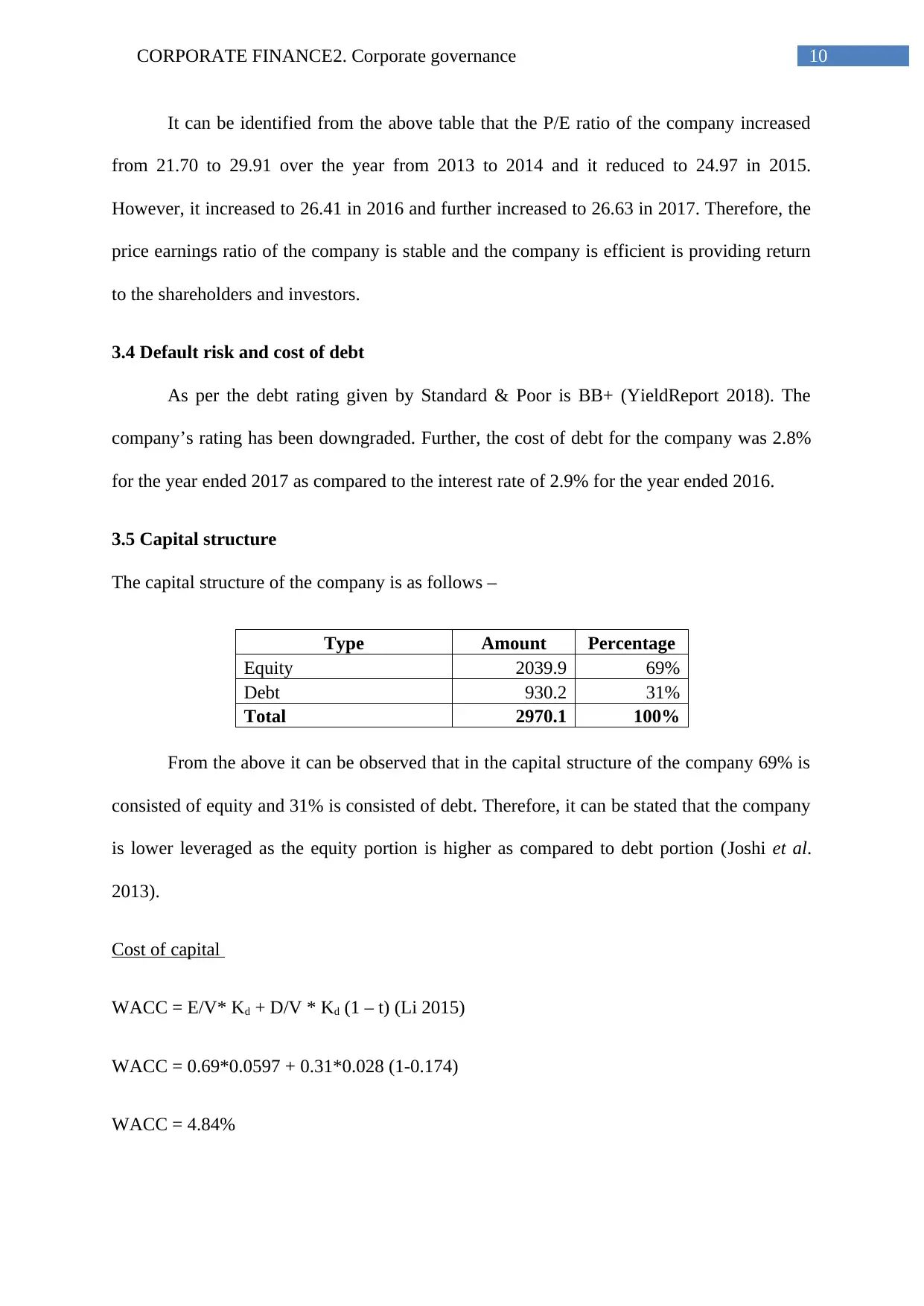
10CORPORATE FINANCE2. Corporate governance
It can be identified from the above table that the P/E ratio of the company increased
from 21.70 to 29.91 over the year from 2013 to 2014 and it reduced to 24.97 in 2015.
However, it increased to 26.41 in 2016 and further increased to 26.63 in 2017. Therefore, the
price earnings ratio of the company is stable and the company is efficient is providing return
to the shareholders and investors.
3.4 Default risk and cost of debt
As per the debt rating given by Standard & Poor is BB+ (YieldReport 2018). The
company’s rating has been downgraded. Further, the cost of debt for the company was 2.8%
for the year ended 2017 as compared to the interest rate of 2.9% for the year ended 2016.
3.5 Capital structure
The capital structure of the company is as follows –
Type Amount Percentage
Equity 2039.9 69%
Debt 930.2 31%
Total 2970.1 100%
From the above it can be observed that in the capital structure of the company 69% is
consisted of equity and 31% is consisted of debt. Therefore, it can be stated that the company
is lower leveraged as the equity portion is higher as compared to debt portion (Joshi et al.
2013).
Cost of capital
WACC = E/V* Kd + D/V * Kd (1 – t) (Li 2015)
WACC = 0.69*0.0597 + 0.31*0.028 (1-0.174)
WACC = 4.84%
It can be identified from the above table that the P/E ratio of the company increased
from 21.70 to 29.91 over the year from 2013 to 2014 and it reduced to 24.97 in 2015.
However, it increased to 26.41 in 2016 and further increased to 26.63 in 2017. Therefore, the
price earnings ratio of the company is stable and the company is efficient is providing return
to the shareholders and investors.
3.4 Default risk and cost of debt
As per the debt rating given by Standard & Poor is BB+ (YieldReport 2018). The
company’s rating has been downgraded. Further, the cost of debt for the company was 2.8%
for the year ended 2017 as compared to the interest rate of 2.9% for the year ended 2016.
3.5 Capital structure
The capital structure of the company is as follows –
Type Amount Percentage
Equity 2039.9 69%
Debt 930.2 31%
Total 2970.1 100%
From the above it can be observed that in the capital structure of the company 69% is
consisted of equity and 31% is consisted of debt. Therefore, it can be stated that the company
is lower leveraged as the equity portion is higher as compared to debt portion (Joshi et al.
2013).
Cost of capital
WACC = E/V* Kd + D/V * Kd (1 – t) (Li 2015)
WACC = 0.69*0.0597 + 0.31*0.028 (1-0.174)
WACC = 4.84%

11CORPORATE FINANCE2. Corporate governance
4. Earnings and cash flow
4.1 Existing investment analysis
Net profit of the company for the year ended has been changed from $ 141.10 million
to $ 220.8 million over the years from 2013 to 2017. The net profit of the company was in
increasing trend. The net profit after tax was as follows – 2013 - $ 141.1 million, 2014 – $
179.7 million, 2015 - $ 193.0 million, 2016 – 198.1 million and for 2017 – 220.8. Therefore,
the company is efficient in earning over the last 5 years. Further, the cash flows of the
company have been increased from $ 504.9 million to 652.0 million over the years from 2016
to 2017. Therefore, the company was efficient in generating positive cash flows over the past
years. Therefore, the from investment aspect the company can be considered as a good
investment opportunity (Bradford, Chen and Zhu 2013).
Profitability ratios –
Ratio (%) 2013 2014 2015 2016 2017
Gross profit margin 92.9 95.9 96.6 95.9 93.8
Operating profit margin -4.16 -4.07 -8.26 -14.53 24.63
Net profit margin 48.38 27.42 32.76 37.57 32.83
ROA 16.69 8.82 10.16 10.58 9.77
ROE 51.01 23.29 27.61 28.69 23.99
Activity ratios –
Ratio 2013 2014 2015 2016 2017
Average collection period 33.42 27.46 23.68 23.02 22.86
Accounts receivable ratio 10.92 13.29 15.41 15.85 15.97
Free cash flow to sales 23.3 27.42 26.18 29.46 19.65
Free cash flow to net income 0.48 1 0.8 0.78 0.6
4. Earnings and cash flow
4.1 Existing investment analysis
Net profit of the company for the year ended has been changed from $ 141.10 million
to $ 220.8 million over the years from 2013 to 2017. The net profit of the company was in
increasing trend. The net profit after tax was as follows – 2013 - $ 141.1 million, 2014 – $
179.7 million, 2015 - $ 193.0 million, 2016 – 198.1 million and for 2017 – 220.8. Therefore,
the company is efficient in earning over the last 5 years. Further, the cash flows of the
company have been increased from $ 504.9 million to 652.0 million over the years from 2016
to 2017. Therefore, the company was efficient in generating positive cash flows over the past
years. Therefore, the from investment aspect the company can be considered as a good
investment opportunity (Bradford, Chen and Zhu 2013).
Profitability ratios –
Ratio (%) 2013 2014 2015 2016 2017
Gross profit margin 92.9 95.9 96.6 95.9 93.8
Operating profit margin -4.16 -4.07 -8.26 -14.53 24.63
Net profit margin 48.38 27.42 32.76 37.57 32.83
ROA 16.69 8.82 10.16 10.58 9.77
ROE 51.01 23.29 27.61 28.69 23.99
Activity ratios –
Ratio 2013 2014 2015 2016 2017
Average collection period 33.42 27.46 23.68 23.02 22.86
Accounts receivable ratio 10.92 13.29 15.41 15.85 15.97
Free cash flow to sales 23.3 27.42 26.18 29.46 19.65
Free cash flow to net income 0.48 1 0.8 0.78 0.6
You're viewing a preview
Unlock full access by subscribing today!
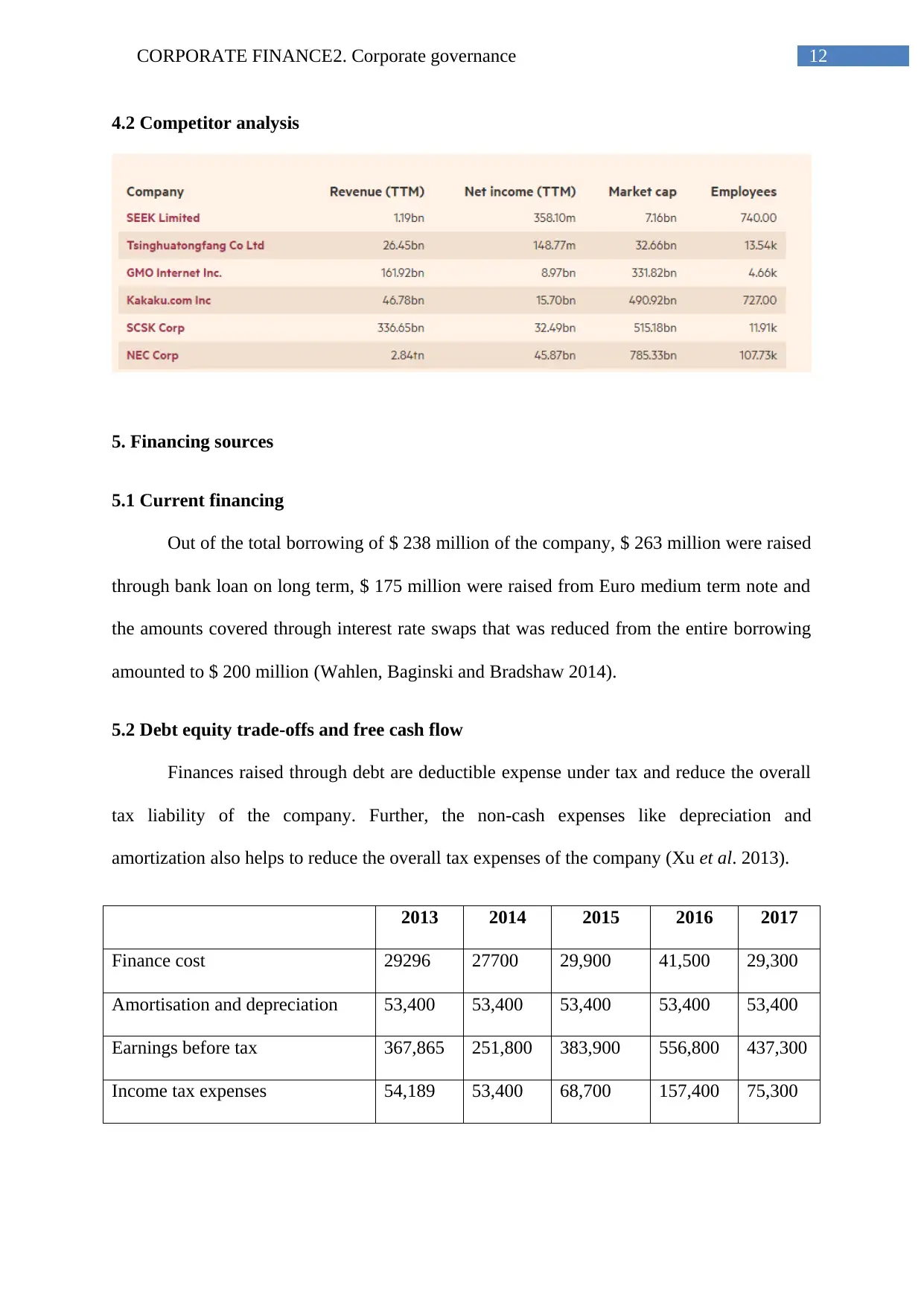
12CORPORATE FINANCE2. Corporate governance
4.2 Competitor analysis
5. Financing sources
5.1 Current financing
Out of the total borrowing of $ 238 million of the company, $ 263 million were raised
through bank loan on long term, $ 175 million were raised from Euro medium term note and
the amounts covered through interest rate swaps that was reduced from the entire borrowing
amounted to $ 200 million (Wahlen, Baginski and Bradshaw 2014).
5.2 Debt equity trade-offs and free cash flow
Finances raised through debt are deductible expense under tax and reduce the overall
tax liability of the company. Further, the non-cash expenses like depreciation and
amortization also helps to reduce the overall tax expenses of the company (Xu et al. 2013).
2013 2014 2015 2016 2017
Finance cost 29296 27700 29,900 41,500 29,300
Amortisation and depreciation 53,400 53,400 53,400 53,400 53,400
Earnings before tax 367,865 251,800 383,900 556,800 437,300
Income tax expenses 54,189 53,400 68,700 157,400 75,300
4.2 Competitor analysis
5. Financing sources
5.1 Current financing
Out of the total borrowing of $ 238 million of the company, $ 263 million were raised
through bank loan on long term, $ 175 million were raised from Euro medium term note and
the amounts covered through interest rate swaps that was reduced from the entire borrowing
amounted to $ 200 million (Wahlen, Baginski and Bradshaw 2014).
5.2 Debt equity trade-offs and free cash flow
Finances raised through debt are deductible expense under tax and reduce the overall
tax liability of the company. Further, the non-cash expenses like depreciation and
amortization also helps to reduce the overall tax expenses of the company (Xu et al. 2013).
2013 2014 2015 2016 2017
Finance cost 29296 27700 29,900 41,500 29,300
Amortisation and depreciation 53,400 53,400 53,400 53,400 53,400
Earnings before tax 367,865 251,800 383,900 556,800 437,300
Income tax expenses 54,189 53,400 68,700 157,400 75,300
Paraphrase This Document
Need a fresh take? Get an instant paraphrase of this document with our AI Paraphraser
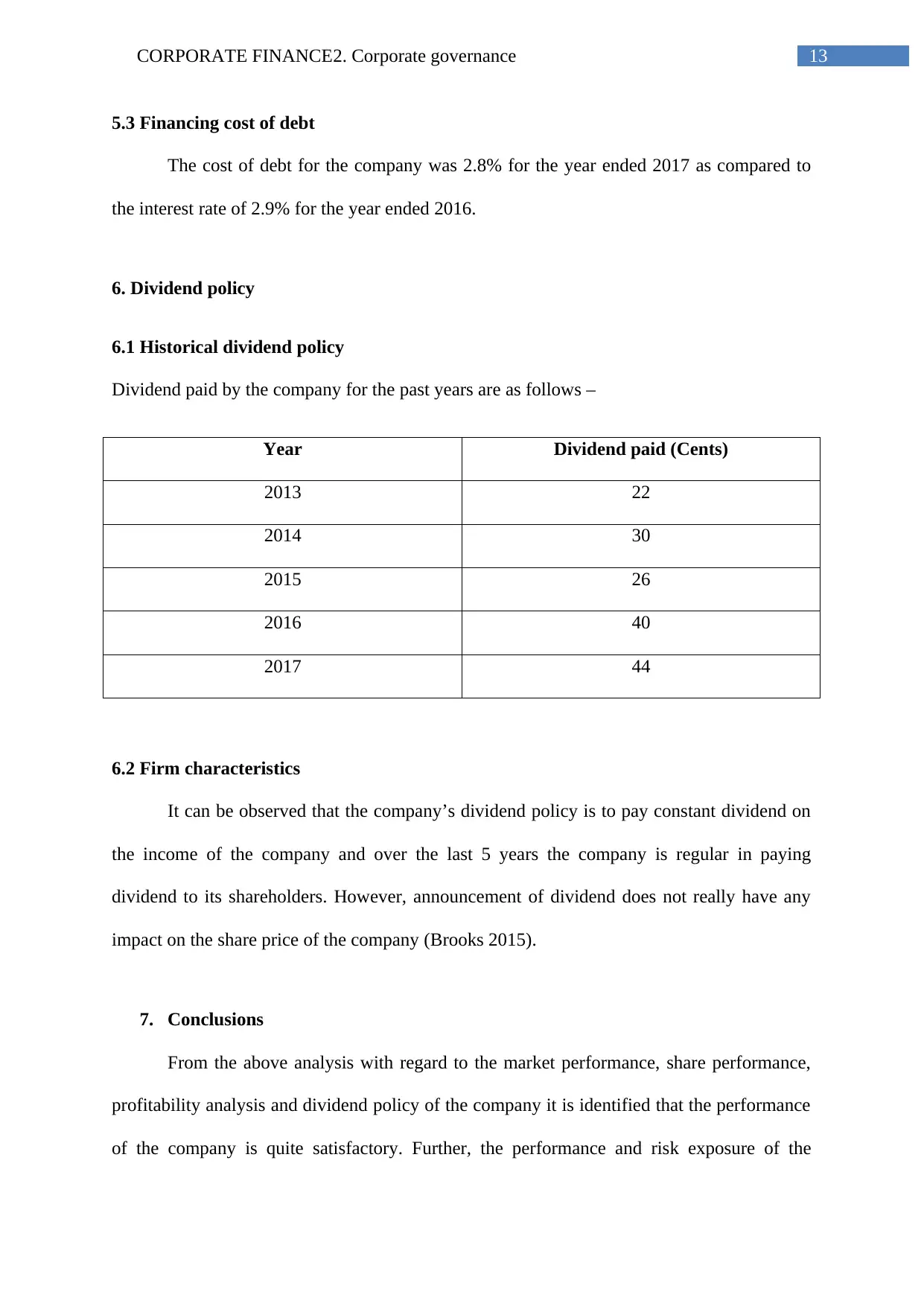
13CORPORATE FINANCE2. Corporate governance
5.3 Financing cost of debt
The cost of debt for the company was 2.8% for the year ended 2017 as compared to
the interest rate of 2.9% for the year ended 2016.
6. Dividend policy
6.1 Historical dividend policy
Dividend paid by the company for the past years are as follows –
Year Dividend paid (Cents)
2013 22
2014 30
2015 26
2016 40
2017 44
6.2 Firm characteristics
It can be observed that the company’s dividend policy is to pay constant dividend on
the income of the company and over the last 5 years the company is regular in paying
dividend to its shareholders. However, announcement of dividend does not really have any
impact on the share price of the company (Brooks 2015).
7. Conclusions
From the above analysis with regard to the market performance, share performance,
profitability analysis and dividend policy of the company it is identified that the performance
of the company is quite satisfactory. Further, the performance and risk exposure of the
5.3 Financing cost of debt
The cost of debt for the company was 2.8% for the year ended 2017 as compared to
the interest rate of 2.9% for the year ended 2016.
6. Dividend policy
6.1 Historical dividend policy
Dividend paid by the company for the past years are as follows –
Year Dividend paid (Cents)
2013 22
2014 30
2015 26
2016 40
2017 44
6.2 Firm characteristics
It can be observed that the company’s dividend policy is to pay constant dividend on
the income of the company and over the last 5 years the company is regular in paying
dividend to its shareholders. However, announcement of dividend does not really have any
impact on the share price of the company (Brooks 2015).
7. Conclusions
From the above analysis with regard to the market performance, share performance,
profitability analysis and dividend policy of the company it is identified that the performance
of the company is quite satisfactory. Further, the performance and risk exposure of the
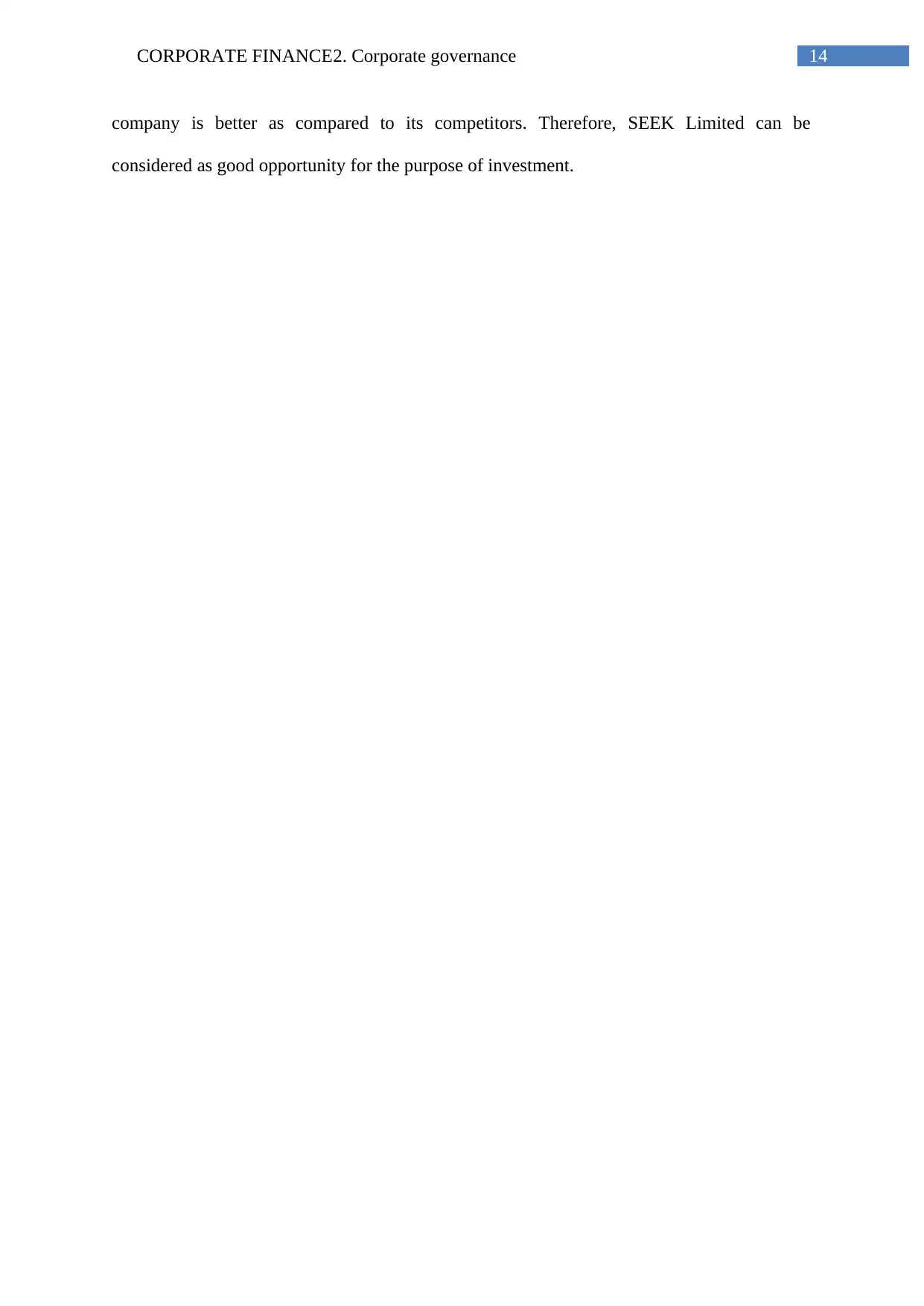
14CORPORATE FINANCE2. Corporate governance
company is better as compared to its competitors. Therefore, SEEK Limited can be
considered as good opportunity for the purpose of investment.
company is better as compared to its competitors. Therefore, SEEK Limited can be
considered as good opportunity for the purpose of investment.
You're viewing a preview
Unlock full access by subscribing today!
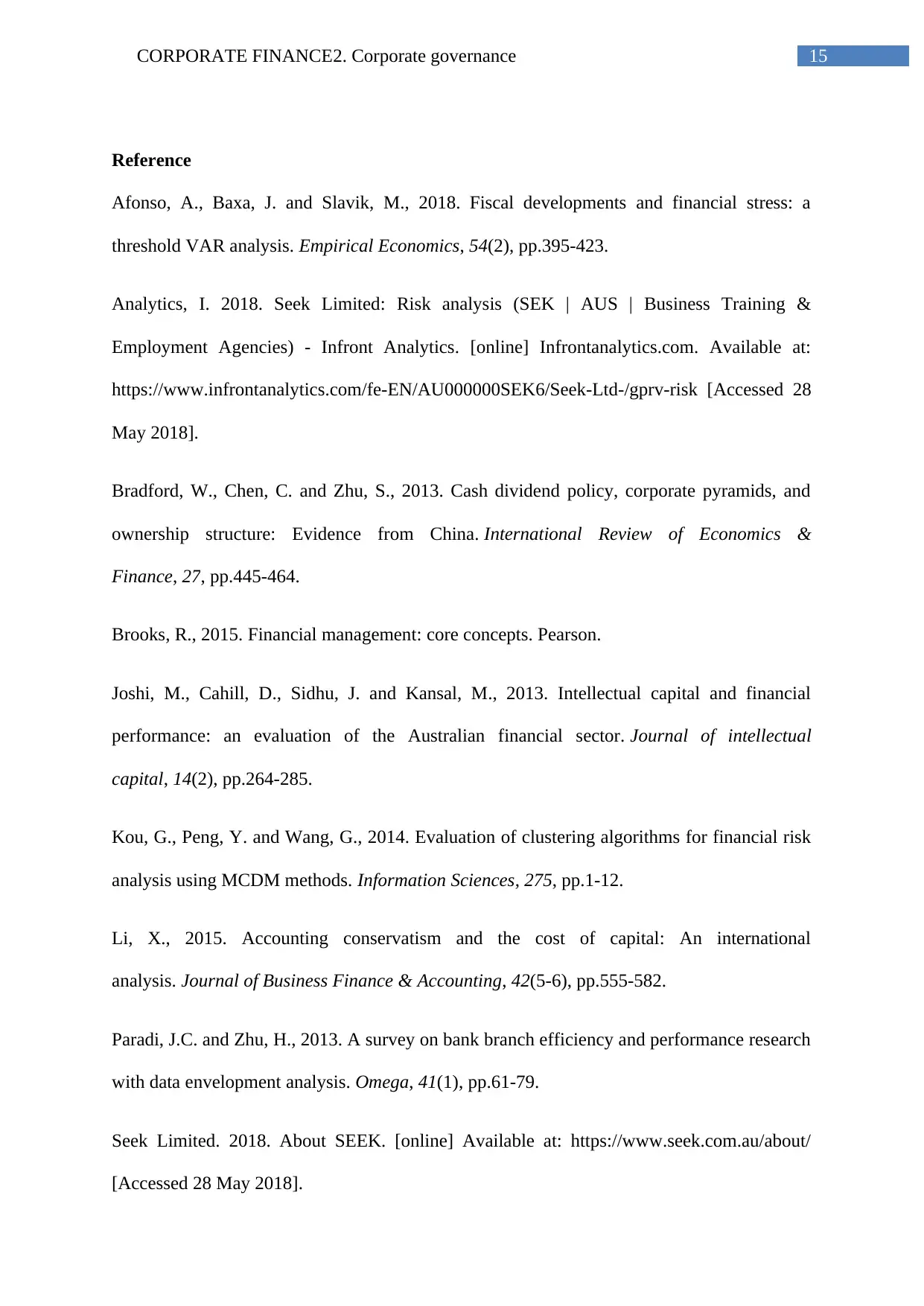
15CORPORATE FINANCE2. Corporate governance
Reference
Afonso, A., Baxa, J. and Slavik, M., 2018. Fiscal developments and financial stress: a
threshold VAR analysis. Empirical Economics, 54(2), pp.395-423.
Analytics, I. 2018. Seek Limited: Risk analysis (SEK | AUS | Business Training &
Employment Agencies) - Infront Analytics. [online] Infrontanalytics.com. Available at:
https://www.infrontanalytics.com/fe-EN/AU000000SEK6/Seek-Ltd-/gprv-risk [Accessed 28
May 2018].
Bradford, W., Chen, C. and Zhu, S., 2013. Cash dividend policy, corporate pyramids, and
ownership structure: Evidence from China. International Review of Economics &
Finance, 27, pp.445-464.
Brooks, R., 2015. Financial management: core concepts. Pearson.
Joshi, M., Cahill, D., Sidhu, J. and Kansal, M., 2013. Intellectual capital and financial
performance: an evaluation of the Australian financial sector. Journal of intellectual
capital, 14(2), pp.264-285.
Kou, G., Peng, Y. and Wang, G., 2014. Evaluation of clustering algorithms for financial risk
analysis using MCDM methods. Information Sciences, 275, pp.1-12.
Li, X., 2015. Accounting conservatism and the cost of capital: An international
analysis. Journal of Business Finance & Accounting, 42(5-6), pp.555-582.
Paradi, J.C. and Zhu, H., 2013. A survey on bank branch efficiency and performance research
with data envelopment analysis. Omega, 41(1), pp.61-79.
Seek Limited. 2018. About SEEK. [online] Available at: https://www.seek.com.au/about/
[Accessed 28 May 2018].
Reference
Afonso, A., Baxa, J. and Slavik, M., 2018. Fiscal developments and financial stress: a
threshold VAR analysis. Empirical Economics, 54(2), pp.395-423.
Analytics, I. 2018. Seek Limited: Risk analysis (SEK | AUS | Business Training &
Employment Agencies) - Infront Analytics. [online] Infrontanalytics.com. Available at:
https://www.infrontanalytics.com/fe-EN/AU000000SEK6/Seek-Ltd-/gprv-risk [Accessed 28
May 2018].
Bradford, W., Chen, C. and Zhu, S., 2013. Cash dividend policy, corporate pyramids, and
ownership structure: Evidence from China. International Review of Economics &
Finance, 27, pp.445-464.
Brooks, R., 2015. Financial management: core concepts. Pearson.
Joshi, M., Cahill, D., Sidhu, J. and Kansal, M., 2013. Intellectual capital and financial
performance: an evaluation of the Australian financial sector. Journal of intellectual
capital, 14(2), pp.264-285.
Kou, G., Peng, Y. and Wang, G., 2014. Evaluation of clustering algorithms for financial risk
analysis using MCDM methods. Information Sciences, 275, pp.1-12.
Li, X., 2015. Accounting conservatism and the cost of capital: An international
analysis. Journal of Business Finance & Accounting, 42(5-6), pp.555-582.
Paradi, J.C. and Zhu, H., 2013. A survey on bank branch efficiency and performance research
with data envelopment analysis. Omega, 41(1), pp.61-79.
Seek Limited. 2018. About SEEK. [online] Available at: https://www.seek.com.au/about/
[Accessed 28 May 2018].
Paraphrase This Document
Need a fresh take? Get an instant paraphrase of this document with our AI Paraphraser
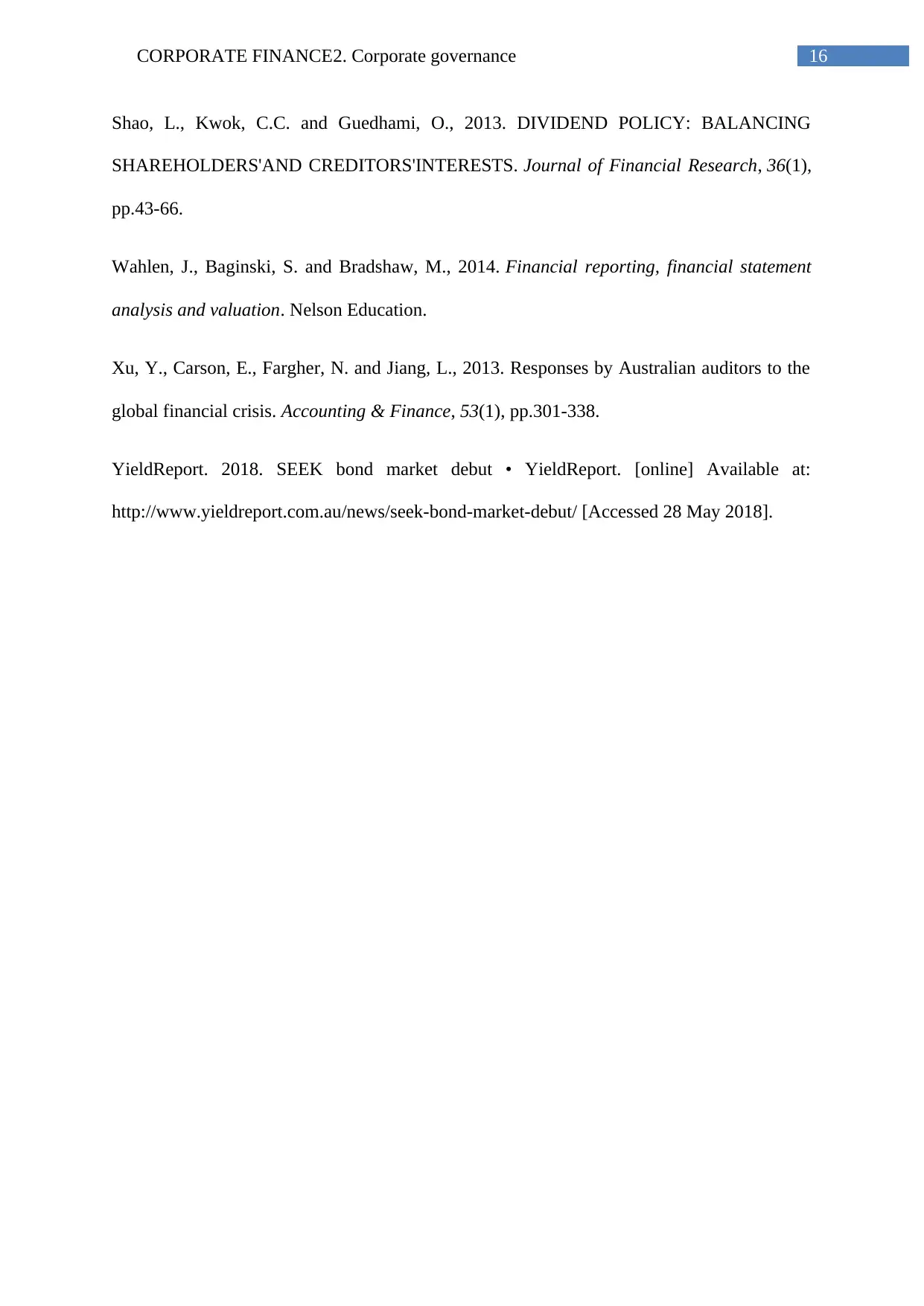
16CORPORATE FINANCE2. Corporate governance
Shao, L., Kwok, C.C. and Guedhami, O., 2013. DIVIDEND POLICY: BALANCING
SHAREHOLDERS'AND CREDITORS'INTERESTS. Journal of Financial Research, 36(1),
pp.43-66.
Wahlen, J., Baginski, S. and Bradshaw, M., 2014. Financial reporting, financial statement
analysis and valuation. Nelson Education.
Xu, Y., Carson, E., Fargher, N. and Jiang, L., 2013. Responses by Australian auditors to the
global financial crisis. Accounting & Finance, 53(1), pp.301-338.
YieldReport. 2018. SEEK bond market debut • YieldReport. [online] Available at:
http://www.yieldreport.com.au/news/seek-bond-market-debut/ [Accessed 28 May 2018].
Shao, L., Kwok, C.C. and Guedhami, O., 2013. DIVIDEND POLICY: BALANCING
SHAREHOLDERS'AND CREDITORS'INTERESTS. Journal of Financial Research, 36(1),
pp.43-66.
Wahlen, J., Baginski, S. and Bradshaw, M., 2014. Financial reporting, financial statement
analysis and valuation. Nelson Education.
Xu, Y., Carson, E., Fargher, N. and Jiang, L., 2013. Responses by Australian auditors to the
global financial crisis. Accounting & Finance, 53(1), pp.301-338.
YieldReport. 2018. SEEK bond market debut • YieldReport. [online] Available at:
http://www.yieldreport.com.au/news/seek-bond-market-debut/ [Accessed 28 May 2018].
1 out of 17
Related Documents
Your All-in-One AI-Powered Toolkit for Academic Success.
+13062052269
info@desklib.com
Available 24*7 on WhatsApp / Email
![[object Object]](/_next/static/media/star-bottom.7253800d.svg)
Unlock your academic potential
© 2024 | Zucol Services PVT LTD | All rights reserved.





